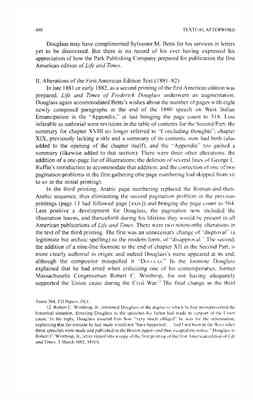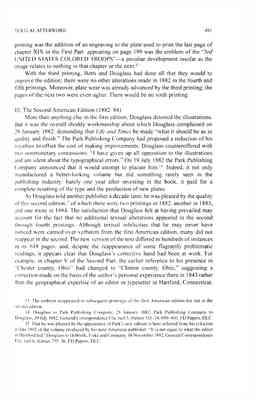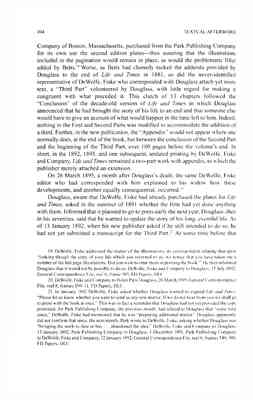Pages
6
490
TEXTUAL AFTERWORD
Douglass may have complimented Sylvester M. Betts for his services in letters yet to be discovered. But there is no record of his ever having expressed his appreciation of how the Park Publishing Company prepared for publication the first American edition of Life and Times.
II. Alterations of the First American Edition Text (1881–82)
In late 1881 or early 1882, as a second printing of the first American edition was prepared, Life and Times of Frederick Douglass underwent an augmentation. Douglass again accommodated Betts's wishes about the number of pages with eight newly composed paragraphs at the end of the 1880 speech on West Indian Emancipation in the "Appendix," at last bringing the page count to 518. Less inferable as authorial were revisions in the table of contents for the Second Part: the summary for chapter XVIII no longer referred to "Concluding thoughts"; chapter XIX, previously lacking a title and a summary of its contents, now had both (also added to the opening of the chapter itself); and the "Appendix" too gained a summary (likewise added to that section). There were three other alterations: the addition of a one-page list of illustrations; the deletion of several lines of George L. Ruffin's introduction to accommodate that addition; and the correction of one of two pagination problems in the first gathering (the page numbering had skipped from xii to xv in the initial printing).
In the third printing, Arabic page numbering replaced the Roman-and-thenArabic sequence, thus eliminating the second pagination problem in the previous printings (page 13 had followed page [xxiv]) and bringing the page count to 564. Less positive a development for Douglass, the pagination now included the illustration leaves, and thenceforth during his lifetime they would be present in all American publications of Life and Times. There were two noteworthy alterations in the text of the third printing. The first was an unnecessary change of "disproval" (a legitimate but archaic spelling) to the modern form, of "disapproval." The second, the addition of a nine-line footnote to the end of chapter XII in the Second Part, is more clearly authorial in origin; and indeed Douglass's name appeared at its end, although the compositor misspelled it "DOUGLAS." In the footnote Douglass explained that he had erred when criticizing one of his contemporaries, former Massachusetts Congressman Robert C. Winthrop, for not having adequately supported the Union cause during the Civil War.12 The final change in the third
frame 584, FD Papers, DLC.
12. Robert C. Winthrop, Jr., informed Douglass of the degree to which he had misrepresented the historical situation, directing Douglass to the speeches his father had made in support of the Union cause. In his reply, Douglass assurced him how "very much obliged" he was for the information, explaining that the mistake he had made would not "have happened . . . had I not been in the West when these speeches were made and published in the Boston papers and thus escaped my notice." Douglass to Robert C. Winthrop, Jr., letter tipped into a copy of the first printing of the first American edition of Life and Times, 3 March 1882, MHiS.
7
TEXTUAL AFTERWORD
491
printing was the addition of an engraving to the plate used to print the last page of chapter XIX in the First Part: appearing on page 199 was the emblem of the "3rd UNITED STATES COLORED TROOPS"—a peculiar development insofar as the image relates to nothing in that chapter or the next.13
With the third printing, Betts and Douglass had done all that they would to improve the edition; there were no other alterations made in 1882 in the fourth and fifth printings. Moreover, plate wear was already advanced by the third printing; the pages of the next two were even uglier. There would be no sixth printing.
III. The Second American Edition (1882–84)
More than anything else in the first edition, Douglass detested the illustrations. But it was the overall shoddy workmanship about which Douglass complained on 28 January 1882, demanding that Life and Times be made "what it should be as to quality and finish." The Park Publishing Company had proposed a reduction of his royalties to offset the cost of making improvements. Douglass counteroffered with two nonmonetary concessions: "I have given up all opposition to the illustrations and am silent about the typographical errors." On 19 July 1882 the Park Publishing Company announced that it would attempt to placate him.14 Indeed, it not only manufactured a better-looking volume but did something rarely seen in the publishing industry: barely one year after investing in the book, it paid for a complete resetting of the type and the production of new plates.
As Douglass told another publisher a decade later, he was pleased by the quality of this second edition,15 of which there were two printings in 1882, another in 1883, and one more in l884. The satisfaction that Douglass felt at having prevailed may account for the fact that no additional textual alterations appeared in the second through fourth printings. Although textual infelicities that he may never have noticed were carried over verbatim from the first American edition, many did not reappear in the second. The new version of the text differed in hundreds of instances in its 618 pages; and, despite the reappearance of some flagrantly problematic readings, it appears clear that Douglass's corrective hand had been at work. For example, in chapter V of the Second Part, the earlier reference to his presence in "Chester county, Ohio" had changed to "Clinton county, Ohio," suggesting a correction made on the basis of the author's personal experience there in 1843 rather than the geographical expertise of an editor or typesetter in Hartford, Connecticut.
13. The emblem reappeared in subsequent printings of the first American edition but not in the second edition.
14. Douglass to Park Publishing Company, 28 January 1882; Park Publishing Company to Douglass, l9 July 1882, General Correspondence File, reel 3, frames 533–34, 600–601, FD Papers, DLC.
15. That he was pleased by the appearance of Park's new edition is here inferred from his criticism in late 1892 of the volume produced by his next American publisher: "It is not equal to what the editor in Hartford did." Douglass to DeWolfe, Fiske and Company, 18 November 1892, General Correspondence File, reel 6, frame 735–36, FD Papers. DLC
8
492
TEXTUAL AFTERWORD
Less easily inferred as authorial, however, are the large majority of such changes. There is no documentation of which textual revisions were Douglass's and which were those made by another hand or hands at the Park Publishing Company.
IV. The English Edition (1882–87)
In the meantime in England, the editor of Christian Age magazine, John Lobb, had taken Life and Times into another phase of its nineteenth-century textualbibliographical history. Correspondence reveals that in December 1881 he had obtained a copy of the autobiography and informed Douglass of his interest in publishing it. Douglass approved his proposal. Then, without the author's personal involvement, Lobb proceeded to edit it and have it typeset for a British readership. On 15 March 1882 he explained to Douglass that he had taken these liberties and by the same mail sent him a copy of the published volume.16 It included not only the unabbreviated introduction by George L. Ruffin appearing in the first printing of the first American edition but newly composed testimonials by the Right Honorable John Bright, M.P., and the Reverend David Thomas, D.D.17 In this thoroughly Anglicized version of Life and Times, Lobb's alterations of the text involved much more than the imposition throughout of British spellings and his own punctuation preferences. He deleted references to numerous individuals whom his British readers would undoubtedly not recognize. He included the Garfield piece inserted by Betts, complete with the still-uncorrected final paragraph written in the third-person singular; but he was wide awake enough to treat Douglass's "Conclusion" appropriately. Although
16. Lobb cabled Douglass on 20 February 1882, asking permission to "republish your life," adding "l will compensate you." Douglass's reply is not extant; but he apparently accepted the propsal, since, in his testimonial dated 24 February that appeared in the English edition of Life and Times, the Reverend David Thomas related that permission to publish it had been given by Douglass. Lobb's 8 March letter to Douglass also seems to confirm that Douglass had given his approval: "Shall be glad to receive the promised lines in reply to my wire at your earliest convenience." These "lines" appear to refer to textual corrections that Douglass informed Lobb he would be sending him, for on 15 March Lobb related that he had received Douglass's "list of needed corrections in the Americanan Edition" but that they had arrived too late for use. Lobb then proffered a consolation, as nebulous as it was unreassuring: "I have anticipated a considerable number" of the corrections "when corrcecting my proofs." John Lobb to Douglass, 20 February, 8, 15 March 1882, General Correspondence File, reel 3, frames 544, 566, 575–76, FD Papers, DLC.
17. If Douglass was disappointed to learn that his corrections did not guide Lobb's work, the Park Publishing Company had at least equal cause for discontent with the publication of the English edition. In his 15 March 1882 letter to Douglass, Lobb declared that he had not known in February when he cabled him that the American edition was available for sale in England. But, in view of the "advanced stage" of his preparation of Life and Times, begun in December, he decided to continue without informing or making an agreement with the Park Publishing Company. Apparently never told by Douglass about the Lobb edition that "has just made its appearance," Park complained on 24 March that it had made arrangements with wholesale houses in Great Britain for the sale of its own edition and had sent them seventy-five copies. Now it must either ask for the return of the books or sell them at a discount. It asked Douglass for his view of the situation. The surviving correspondence does not include Douglass's reply. Park Publishing Company to Douglass, 24 March 1882, General Correspondence File, reel 3, frame 580, FD Papers, DLC.
9
TEXTUAL AFTERWORD
493
Lobb did not take the opportunity to move the Garfield piece to the "Appendix," he did separate it from the "Conclusion," assigning the latter a chapter of its own. In fact, rather than expanding the "Appendix," he removed the Freedmen's Monument speech; in the English edition it appears in chapter XV of the Second Part, where it immediately follows Douglass's 1881 description of the District of Columbia ceremony honoring Abraham Lincoln in 1876.
Especially noteworthy among the hundreds of differences between the first American edition and the one published by the Christian Age Office is Lobb's censorship of a 345-word passage in chapter X of the Second Part. He deleted the two paragraphs in which Douglass angrily pilloried an Englishman, Colonel Hugh Forbes, who had exposed and thus thwarted one of John Brown's schemes for triggering a slave insurrection. New printings in 1883, 1884, and 1887 yielded another noteworthy alteration in the same part of the 1881 text—this one reflecting not editorial tampering by Lobb but self-censorship by Douglass. As has been noted, in the initial two printings of the first American edition Douglass tartly criticized Robert C. Winthrop for not having displayed sufficient dedication to the Union war effort in 1861—65. Informed that he had erred grievously in his assessment, Douglass recanted in 1882 in a footnote added to the third printing, and the footnote reappeared in chapter XII of all subsequent American publications of Life and Times. In the English edition there was no such footnote. Instead, beginning with its second printing, the paragraph-length passage was rewritten, energetically lauding Winthrop as an exemplary Union loyalist. Douglass's responsibility for this change in the text in 1883 is as clear as an inference from evidence internal to the work's textual history can be. But this stands as the only instance in which Douglass's revising hand manifests itself. As to which of Lobb's changes in the first American edition's text Douglass may have privately welcomed in correspondence, there is no more documentation than there is for the authority of the revisions that appeared in the second American edition. That is, there is none.
V. The Expanded Second American Edition (1892–95)
Deposited for copyright in December 1892 but declaring itself an 1893 publication on its title page is the most dramatic American transformation of the autobiography that occurred during Douglass's lifetime.18 DeWolfe, Fiske and
18. In July 1889 the Park Publishing Company assured Douglass that it continued to market his autobiography energetically. "We have rushed and re-rushed the book connstantly." In December 1891, however, it announced that the "old edition is exhausted" and made no mention of the possibility of a new printing, in part because it had been informed "some months since" by DeWolfe, Fiske and Company that that firm planned to publish a "new edition." But this would not mark an end to Park's involvement, for it entered into an arrangement with the new publisher: its subscription sales agents were "anxious to resume work on this book"; and in January 1892 Park wrote to DeWolfe, Fiske, asking when copies would be available. Park Publishing Company to Douglass, 14 July 1889; Park Publishing Company to DeWolfe, Fiske and Company, 1 December 1891, 12 January 1892, General Correspondence File, reel 5, frames 482–83; reel 6, frames 340, 380, FD Papers, DLC.
10
494
TEXTUAL AFTERWORD
Company of Boston, Massachusetts, purchased from the Park Publishing Company for its own use the second edition plates—thus assuring that the illustrations included in the pagination would remain in place, as would the problematic filler added by Betts.19 Worse, as Betts had clumsily tacked the addenda provided by Douglass to the end of Life and Times in 1881, so did the never-identified representative of DeWolfe, Fiske who corresponded with Douglass attach yet more text, a "Third Part" volunteered by Douglass, with little regard for making it congruent with what preceded it. This clutch of 13 chapters followed the "Conclusion" of the decade-old version of Life and Times in which Douglass announced that he had brought the story of his life to an end and that someone else would have to give an account of what would happen in the time left to him. Indeed, nothing in the First and Second Parts was modified to accommodate the addition of a third. Further, in the new publication, the "Appendix" would not appear where one normally does, at the end of the book, but between the conclusion of the Second Part and the beginning of the Third Part, over 100 pages before the volume's end. In short, in the 1892, 1895, and one subsequent, undated printing by DeWolfe, Fiske and Company, Life and Times remained a two-part work with appendix, to which the publisher merely attached an extension.
On 26 March 1895, a month after Douglass's death. the same DeWolfe, Fiske editor who had corresponded with him explained to his widow how these developments, and another equally consequential, occurred.20
Douglass, aware that DeWolfe, Fiske had already purchased the plates for Life and Times, asked in the summer of 1891 whether the firm had yet done anything with them. Informed that it planned to go to press early the next year, Douglass, then in his seventies, said that he wanted to update the story of his long, eventful life. As of 13 January 1892, when his new publisher asked if he still intended to do so, he had not yet submitted a manuscript for the Third Part.21 At some time before that
19. DeWolfe, Fiske addressed the maatter of the illustrations, its correspondent relating that upon "looking though the copy or your life which you returned to us, we notice that you have taken out a number of the full page illustrations. Did you wish to omit them in printing the book?" He then informed Douglass that it would not be possible to do so. DeWolfe, Fiske and Company to Douglass, 15 July 1892, General Correspondence File, reel 6, frame 585, FD Papers, DLC.
20. DcWolfe, Fiske and Company to Helen Pitts Douglass, 26 March 1895, General Correspondence File, reel 8, frames 309–11, FD Papers, DLC.
21. In January 1892 DeWolfe, Fiske asked whether Douglass wanted to expand Life and Times. "Please let us know whether you want to send us any new matter. If we do not hear from you we shall go to press with the book at once." This was in fact a reminder that Douglass had not yet provided the copy promised; for Park Publishing Company, the previous month, had related to Douglass that "some time since," DeWolfe, Fiske had mentioned that he was "preparing additional matter." Douglass apparently, did not confirm that since, the next month, Park wrote to DeWolfe, Fiske, asking whether Douglass was "bringing the work to date or has . . . abandoned the idea." DeWolfe, Fiske and Company to Douglass, 13 January 1892; Park Publishing Company to Douglass, 1 December 1891; Park Publishing Company to DeWolfe, Fiske and Company, 12 January 1892, General Corresrondence File, reel 6, frames 340, 380, FD Papers, DLC.




